Exploring Hydrofoil Wings in Kitesurfing and Kiteboarding
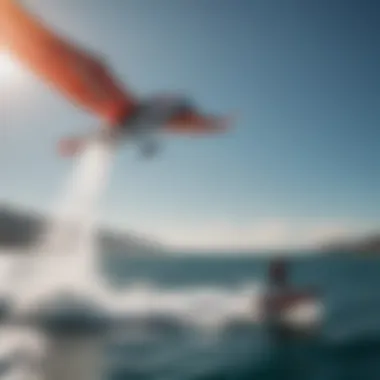
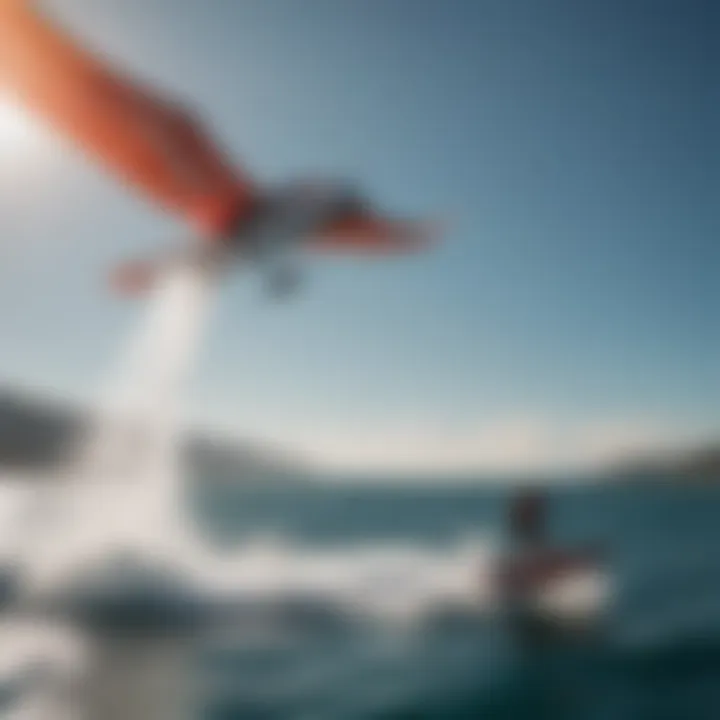
Intro
Kitesurfing and kiteboarding have experienced a significant evolution over the years, not just in techniques but also in the equipment being used. One of the most notable advancements in this realm is the rise of hydrofoil wings. These innovations have brought a new dimension to the activities that many enthusiasts find thrilling, allowing riders to glide above the water with minimal drag.
Hydrofoil wings work on a principle similar to that of an airplane wing. When a rider gains speed, the hydrofoil lifts the board above the water's surface, reducing resistance and enabling smoother rides. This unique form of riding has opened new doors for both casual riders and seasoned pros alike, making it essential to explore the ins and outs of hydrofoil technology.
In this article, we'll delve into multiple aspects of hydrofoil wings, from their design and types to practical applications in kitesurfing and kiteboarding. Whether you're just starting out or looking to refine your skills, understanding the nuances of hydrofoils can enhance your experience.
Equipment Reviews
In this segment, we will take a closer look at the gear that complements the hydrofoil experience in kitesurfing and kiteboarding.
Kites
Kites are a fundamental part of kitesurfing and kiteboarding, acting as the engine that propels you forward. Here are some key aspects to consider:
- Shapes: Different shapes affect performance; for instance, delta kites offer stability in varied winds, while bow kites give more power.
- Sizes: Bigger kites catch more wind, which can be advantageous in lighter conditions, but a smaller kite is easier to control in stronger winds.
- Materials: Look for kites made of durable yet lightweight fabrics, like Ripstop Nylon, which offer good longevity without sacrificing performance.
Popular brands include North Kites, Cabrinha, and F-One, all of which present kites suited for different riding styles and conditions.
Boards
When it comes to the boards compatible with hydrofoil wings, you’ll find that choice matters.
- Twintips: Ideal for freestyle and are suitable for general riding.
- Directional Boards: Better for wave riding and typically offer improved control in an ocean swell.
Each design varies based on construction material, weight, and intended riding style. Brands like Slingshot and Liquid Force offer commendable models that cater to varying preferences.
Accessories
The right accessories can enhance your kitesurfing experience considerably. Here’s a quick breakdown of some must-have items:
- Harnesses: A good harness distributes the load evenly, so you stay comfortable while controlling your kite.
- Lines: Make sure to get high-quality, durable lines that can handle conditions without breaking.
- Pumps: A reliable pump is essential for quickly inflating your kites; some kites come with double-action pumps that speed up the process significantly.
- Safety Gear: Always include a helmet and impact vest as they play a crucial role in protecting you during your sessions.
These elements all come together to form a robust setup for kitesurfing or kiteboarding with hydrofoils, making sure that you're equipped for any adventure on the water.
Understanding Hydrofoil Wings
Understanding hydrofoil wings is fundamental for both kitesurfers and kiteboarders looking to elevate their experience on the water. These wings are not just a fad in the sports world; they redefine the boundaries of what can be achieved while gliding over waves. Hydrofoils allow more efficient movement over water, making it possible to ride in lighter winds and harness speed and agility that was previously unattainable.
The significance of hydrofoil wings extends beyond mere performance enhancements. They reshape how riders engage with the elements, emphasizing a unique connection to the water. By minimizing drag and harnessing lift efficiently, riders can achieve smoother and more controlled rides. This technology is revolutionizing water sports, allowing enthusiasts to push limits and explore new possibilities.
Key benefits of understanding hydrofoil wings include:
- Improved Performance: Speed and efficiency get a boost with optimized lift.
- Versatility: Adaptable for various riding styles, including tricks or long-distance cruising.
- Extended Riding Conditions: Makes it easier to kite in less-than-ideal wind scenarios.
The considerations around hydrofoil wings include the learning curve involved, varying skill levels, and the meticulous design factors that impact performance. These elements intertwine, creating a complex yet fascinating landscape for riders eager to explore every nuance of hydrofoiling.
"Hydrofoils change the game; it’s not just about getting on the water, but how you ride it!"
What is a Hydrofoil?
A hydrofoil is a submerged wing that lifts a watercraft above the surface of the water when it reaches a certain speed, greatly reducing drag. Essentially, it's a modern twist on the design principles observed in aviation, tailored for aquatic environments. When kitesurfers or kiteboarders utilize hydrofoils, they can achieve a sensation akin to flying above the water surface. This lift occurs when the foil interacts with the water moving past it, creating a pressure differential — just like an airplane wing does in the air.
The hydrofoil comprises three main components: the mast, the wings, and the fuselage, which together allow for optimal performance in various conditions. The magic lies in the wings, which are designed to generate lift effectively and efficiently, making the elevation from water possible.
Principles of Lift and Drag
The principles of lift and drag are crucial to understanding how hydrofoil wings work. Lift is generated when the foil moves through the water. As water flows over the wing shape, differences in pressure develop, resulting in upward force. This force is what allows the board and rider to rise above the water surface.
In contrast, drag is the resistance felt as the water opposes the movement of the foil. Balancing these two forces is critical for optimal hydrofoil operation. Riders can maximize lift while minimizing drag through careful choice of speed and angle of attack (the angle at which the wing meets the oncoming water flow).
Some important notes about lift and drag include:
- Increase Speed: Higher speed generally results in increased lift, providing smoother rides.
- Angle of Attack: Adjusting the angle can optimize performance, reducing drag in maneuvers.
- Water Conditions: Smooth water is conducive for effective lift, while choppy conditions can increase drag.
Basic Anatomy of Hydrofoil Wings
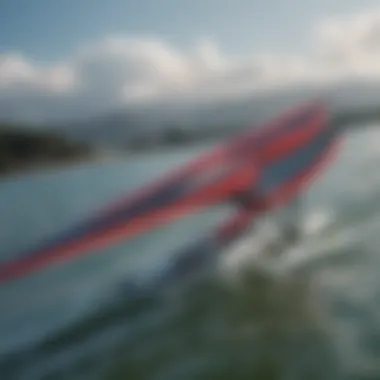
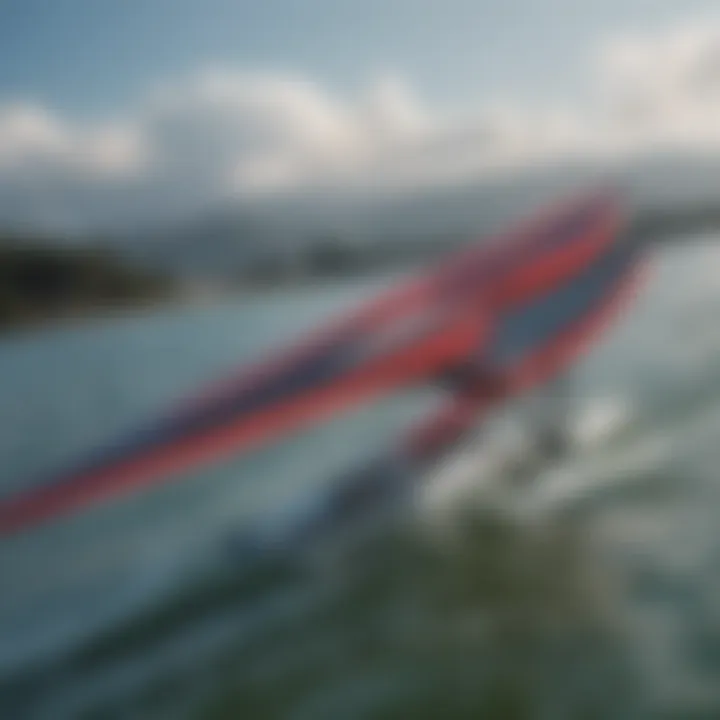
Hydrofoil wings feature several critical anatomical components that define their performance. Understanding these parts can significantly improve rider experience.
- Wings: This is where the lift happens. Typically, hydrofoils have an upper surface designed to be more curved than the lower surface to enhance lift.
- Mast: This vertical section connects the wings to the board. The mast's height can influence buoyancy, directly affecting stability and performance in different water conditions.
- Fuselage: It connects the mast to the wings and can affect the turning radius and maneuverability.
Wings come in various designs, shapes, and sizes, each serving distinct purposes depending on riding styles and conditions. For instance, a longer, thinner wing is ideal for speed, while a wider wing might be better suited for stability and early lift.
Understanding these anatomical elements and how they interact fosters better equipment selection and riding techniques among kitesurfers and kiteboarders alike.
Types of Hydrofoil Wings
Understanding the various types of hydrofoil wings is crucial for anyone looking to enhance their experience in kitesurfing and kiteboarding. Different wings serve distinct purposes, and selecting the right type can significantly impact performance, maneuverability, and enjoyment. Each kind of hydrofoil wing is tailored for specific riding styles, conditions, and rider preferences. This section delves into three primary types of hydrofoil wings: freeride, race, and wave wings, shedding light on their unique attributes, advantages, and considerations for riders.
Freeride Hydrofoil Wings
The freeride hydrofoil wings are often regarded as versatile options for mid-level to advanced riders who seek a blend of performance and comfort. These wings are designed to provide maximum stability and ease of use across a wide range of conditions.
Key features include:
- Large Surface Area: This characteristic offers excellent lift at lower speeds, making it easier for riders to get up on foil without needing strong winds.
- Balanced Design: The wing’s shape promotes an easy ride, crucial for those looking to casually cruise around.
- Adaptability: Freeride wings work well in different water conditions, from flat lakes to choppy seas.
In essence, freeride hydrofoil wings are perfect for riders intending to enjoy leisurely sessions while experimenting with tricks and jumps, providing a forgiving ride that caters to various skill levels.
Race Hydrofoil Wings
Race hydrofoil wings are built with speed in mind. These wings cater to the competitive kitesurfer or kiteboarder, emphasizing performance over comfort. Riders looking to slice through the water with precision will find these wings outfitted for maximum efficiency.
Several notable features of race hydrofoil wings are:
- Narrow Profile: This design minimizes drag, allowing riders to reach higher speeds.
- Stiff Construction: The rigidity of the wings aids in translating rider input into faster acceleration and quick responses.
- Optimal Lift: Designed to fly efficiently at higher speeds, these wings can often require more power to get them foiling.
Riders aiming for competition or speed records will find race hydrofoil wings necessary for achieving peak performance. It’s important to note that while these wings enable impressive speed, they can be less forgiving for novice riders.
Wave Hydrofoil Wings
Wave hydrofoil wings are specifically tailored for those who are passionate about riding waves. They provide the agility necessary to navigate tidal swells and surf conditions, proving essential for kitesurfing enthusiasts who thrive on embracing nature’s dynamism.
Distinct characteristics include:
- Curved Shape: The curvature assists in catching and riding waves smoothly, adapting quickly to changing water flows.
- Shorter Profile: This limits drag while without sacrificing lift, allowing for quick turns and responsive movements.
- Focus on Maneuverability: These wings enable riders to change direction rapidly, making them ideal for tackling waves without losing speed.
In summary, wave hydrofoil wings represent a fantastic choice for those who want to leverage the natural elements and carve through the surf with agility. Choosing the right hydrofoil wing type is vital for maximizing the overall kitesurfing experience. Aligning your choice with your riding style, skill level, and conditions will help ensure you’re set for success out on the water.
Hydrofoil Wing Design Factors
When it comes to hydrofoil wings, the design factors play a crucial role in their performance and suitability for kitesurfing and kiteboarding. The relationship between the design and how effectively the wing operates can make or break a rider's experience on the water. A keen understanding of these factors can not only enhance performance but can also lead to better control, efficiency, and overall enjoyment.
Wing Shape and Profile
The shape and profile of a hydrofoil wing directly impact lift and drag, making them essential considerations for any rider. It's not just about looking sleek; the design must facilitate the hydrofoil's ability to rise above the water's surface. Wings come in different profiles, including high aspect ratio, which reduces drag and improves efficiency, and low aspect ratio, which provides more stability but can be less efficient at higher speeds.
Riders might find that a more pronounced curvature (camber) helps with lift at slower speeds, while flatter designs can be more appropriate for high-speed conditions. This means that depending upon the rider’s style—whether they’re carving out turns, racing, or simply cruising—choosing the right wing shape can feel like picking the perfect shoe for a marathon.
Material Selection
The choice of materials used in constructing hydrofoil wings also comes into play significantly during design. Lightweight yet durable materials help in achieving better responsiveness while maintaining strength. Carbon fiber is often favored for its high strength-to-weight ratio, while aluminum may offer a more budget-friendly option albeit at the cost of some performance.
Moreover, selecting the right material can affect how the wing performs in different environmental conditions, making it essential to think critically about the intended use. A rider going out in harsh conditions may want something stronger, whereas someone who typically rides in calmer waters might prioritize weight over durability. The decisions made here can lead to vastly different experiences on the water.
Size Considerations
Size does not merely refer to the dimensions of the wing itself but also encompasses the rider's weight and riding style. The larger the wing, generally, the more lift it provides, but at the expense of some speed. This creates an interesting balance. For beginners, a larger wing might seem beneficial for stability and ease of use, however, as skills develop, riders may opt for smaller wings to enjoy quicker maneuvers.
"Finding the right size for your hydrofoil wing is akin to tailoring a suit – it should fit you just right to feel comfortable and perform optimally."
As a rider becomes more experienced, understanding how size influences performance allows for reflected personal preferences in choice of equipment. There are no blanket solutions, and knowing the nitty-gritty details of each ride can facilitate better decisions in the long run. Each rider's unique body type, level of expertise, and riding conditions ought to correspond harmoniously to the size of the hydrofoil for the best outcomes.
Performance Implications
Understanding how hydrofoil wings impact the performance of kitesurfing and kiteboarding is paramount for enthusiasts looking to elevate their experience on the water. These wings enhance the way a rider interacts with both the wind and water, promising improvements in speed, stability, and adaptability. Let’s dive into the specific implications of these performance aspects.
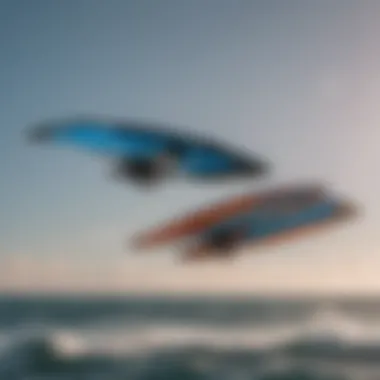
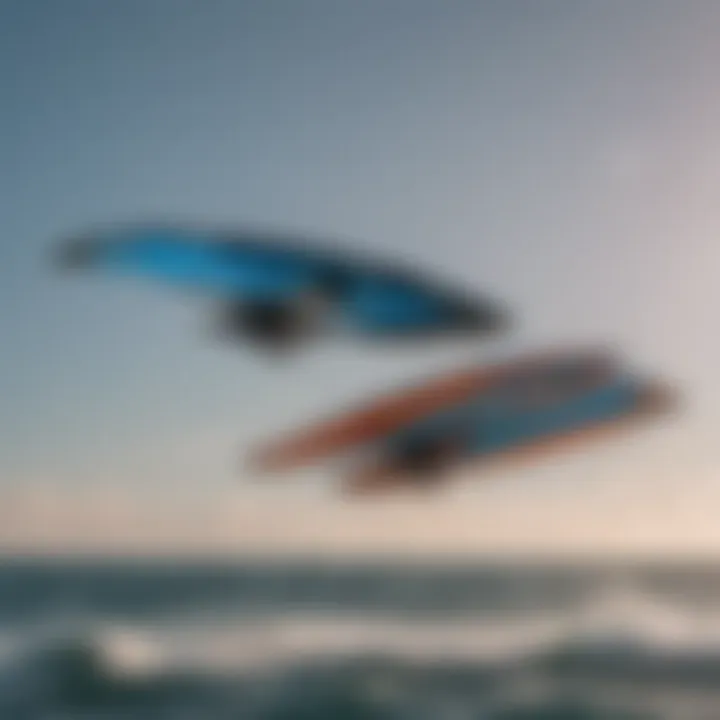
Speed and Efficiency
When kitesurfers or kiteboarders engage with hydrofoil wings, they often notice an immediate surge in speed. Hydrofoil technology allows a rider to glide above the water’s surface, significantly reducing drag. Thus, they can harness the wind more effectively.
The result is not just a fleeting boost; it’s a fundamental shift in how fast one can travel across the water. Riders often describe the sensation as exhilarating since, at times, it feels like flying.
Key advantages of speed and efficiency include:
- Reduced water resistance: Operating above the water minimizes the friction encountered by traditional boards, allowing for greater acceleration.
- Better wind utilization: Riders can maintain speed even with lighter wind conditions, as the foil’s lift works effectively to keep them elevated.
- Smoother transitions: As hydrofoils cut cleanly through the waves, it leads to fewer interruptions in flow, allowing one to achieve consistently high speeds with less effort.
Stability and Control
Stability is another critical element when discussing hydrofoil performance. When a rider is elevated above the water, they encounter a different set of challenges and advantages in controlling the board. For those skilled in balancing their weight and managing the kite, hoisting up on a hydrofoil can feel like riding a well-tuned machine.
Some of the stability benefits include:
- Reduced choppy water effects: Since the hydrofoil keeps the rider airborne, they are less affected by surface inconsistencies, making for a smoother ride even in choppy conditions.
- Greater maneuverability: Advanced riders can exploit this stability to perform turns and tricks with more precision. Elevation provides a unique perspective that can turn the tides in competitive settings.
"Hydrofoil riding feels like dancing on the water, where every motion is amplified by efficiency and stability."
Adapting to Different Conditions
The versatility of hydrofoil wings is a game changer for kite sports. When conditions shift—be it gusty winds or varying water surfaces—these wings adapt, enhancing the overall riding experience. A key factor is the rider’s choice that matches their skill level and intended use.
Some aspects worth noting include:
- Wind range: Hydrofoils can perform in a wide range of wind conditions compared to traditional setups, allowing riders to venture out when others may find it unfeasible.
- Variable water conditions: Saltwater, freshwater, choppy, or flat—hydrofoils can provide a stable ride across different environments, showing their adaptability.
- Skill development: Both novices and veterans can find their footing; beginners may adapt to conditions quicker as the foil facilitates learning, while experienced riders can experiment with advanced techniques.
By considering these performance implications, riders can make informed decisions about their equipment choices, enhancing their enjoyment and mastery of kitesurfing and kiteboarding.
Rider Considerations
The world of hydrofoiling is indeed a thrilling experience, but it comes with its own set of nuances related to rider considerations. Understanding how these factors impact performance and safety can be the difference between a fun ride and a challenging experience.
Skill Level Impact
When diving into hydrofoiling, your skill level plays a pivotal role. For beginners, the learning curve can be steep yet exhilarating. Hydrofoils require finesse in balance and timing, making it essential for new riders to become comfortable on a traditional board first. Every wave and gust of wind can feel like a dance of sorts, where maintaining coordination becomes crucial.
Key points for beginners:
- Take your time: Don't rush into hydrofoiling. Spend ample time practicing on a regular board.
- Seek professional lessons: Engaging with an experienced instructor can drastically shorten the learning process.
- Start with larger wings: Bigger wings offer more lift at slower speeds, providing better stability as you find your bearings.
As your skills improve, you'll notice subtle shifts in performance. More experienced riders can experiment with various wing shapes and sizes, balancing speed and control to suit their preference. Ultimately, it’s about finding that sweet spot where agility meets stability.
Safety Concerns
Safety cannot be overstated when discussing hydrofoil wings. The risk of accidents is higher due to the speed and elevation involved. There are a few essential safety measures to consider, which can make all the difference in ensuring a safe ride.
- Wear protective gear: Helmets, impact vests, and other safety equipment are fundamental. They shield against falls or collisions.
- Be aware of your surroundings: Whether it's fellow riders or potential obstacles in the water, keeping a keen eye on your environment is crucial.
- Know your limits: Hydrofoiling can provide a sense of invincibility, but it's important to recognize when conditions are too risky. Strong winds or crowded waters can lead to complications.
"In the realm of extreme sports, preparation is your armor. Equip yourself, stay alert, and know your limits."
Taking these precautions not only ensures your safety but also enhances the overall experience, allowing you to focus on enjoyment rather than stress.
Suitability for Kitesurfing vs. Kiteboarding
When discussing hydrofoil wings, it's equally important to understand how they fit into kitesurfing and kiteboarding. While the two disciplines share similarities, their differences can greatly influence your choice of hydrofoil setup.
Kitesurfing:
In kitesurfing, the primary goal is to harness the wind effectively, enabling skilled riders to perform tricks and maneuvers. Hydrofoil wings can elevate the ride, providing a unique glide and reducing drag. Riders often prefer hybrid designs that blend the maneuverability of traditional kitesurfing with the efficiency found in hydrofoiling.
Kiteboarding:
On the flipside, kiteboarding tends to focus more on high speeds and a smoother ride over calmer waters. As such, riders often opt for specialized hydrofoil wings designed for speed stability. These setups are generally larger and offer more lift, appealing to those craving a fast, uninterrupted flight above the water.
In essence, choosing the right style boils down to personal objectives and riding conditions. Both kitesurfing and kiteboarding benefit from hydrofoils, but understanding how each discipline interacts with the technology will help you decide the best approach for your needs.
Maintenance and Care for Hydrofoil Wings
Proper mulitasking in the world of hydrofoil wings goes beyond just the ride itself; maintenance and care play a pivotal role in ensuring longevity and performance. Hydrofoils, while innovative, are also subjected to harsh marine environments. Saltwater, sand, and UV exposure can take their toll. Developing a consistent maintenance routine is crucial, not only for keeping the equipment in peak condition, but also for enhancing rider safety and performance. A well-maintained hydrofoil wing ensures you can focus on enjoying your time on the water instead of worrying about potential gear malfunctions.
Regular Inspection Practices
Frequent inspections help identify any wear and tear before they escalate into bigger problems. Regular checks should encompass both structural and cosmetic aspects. Look for signs of scratches, dents, or corrosion on the foil and mast. Components like the fuselage and wings should firm and free of cracks. Additionally, make sure that all screws and fittings are tight; this could be the difference between a smooth ride and a disaster when you’re out on the waves. A simple checklist after each session can keep everything in check:
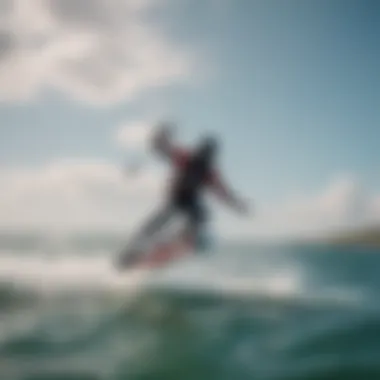
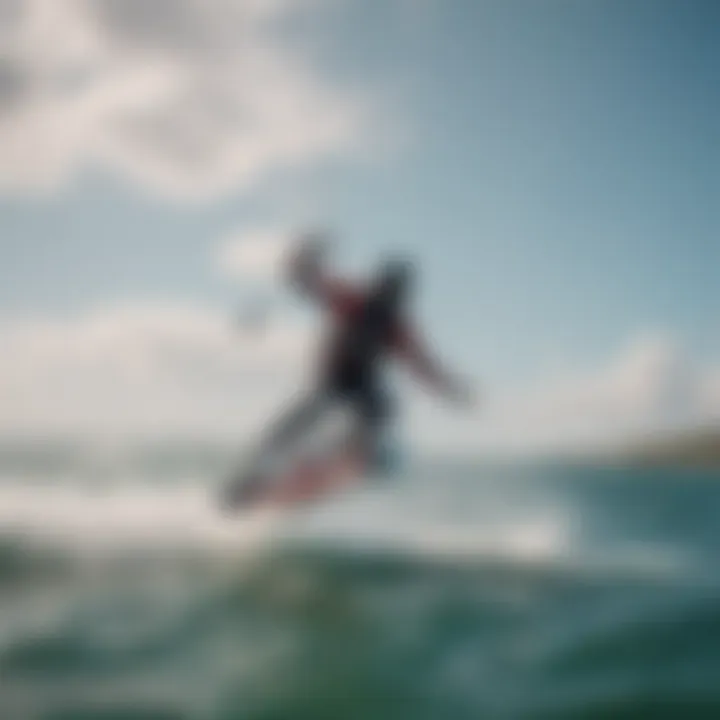
- Check for visible damage on the wing and mast
- Inspect all connections for tightness
- Look for sand or debris caught in any moving parts
By performing these checks routinely, you can catch potential issues early, which saves both time and money on repairs.
Cleaning Techniques
After a day in the water, many riders may be tempted to toss their hydrofoils aside. This, however, is a recipe for trouble. Salt accumulation can lead to corrosion and will degrade performance over time. A good cleaning routine should involve a few simple steps:
- Rinse with fresh water: It might seem basic, but a thorough rinse can remove the salt and sand buildup that can cause damage.
- Use a non-abrasive cloth or sponge: Gently wipe the surface to prevent scratches while removing grime.
- Avoid cleaners containing harsh chemicals: These can corrode materials like aluminum or carbon fiber commonly used in hydrofoil construction.
- Dry completely: After rinsing, always dry your gear to avoid water pooling, which can lead to further corrosion.
By integrating these cleaning steps into your post-ride routine, you’ll help ensure that your hydrofoils are ready to ride whenever you are.
Storage Recommendations
After cleaning and inspecting your hydrofoil wings, proper storage becomes the final puzzle piece in maintaining your gear's longevity. How and where you store them can significantly impact their condition. Here are a few tips:
- Avoid direct sunlight: Store your foil in a shaded area or inside a designated bag. Prolonged sun exposure can weaken materials and fade colors.
- Keep it dry: Ensure that the storage environment is low in humidity, as moisture can lead to rust or mold growth.
- Use a dedicated bag or cover: This helps prevent scratches and dings while also keeping the components organized. A padded bag specifically designed for hydrofoils can prevent these accidents.
- Store upright or flat: Depending on the design, choose a position that prevents bending or warping. Keeping them level reduces stress on the mounting components.
Following these guidelines enables you to preserve your hydrofoil investment and ensures that you can hit the water worry-free when the mood strikes. In the world of kitesurfing and kiteboarding, every session is an opportunity to connect with nature. Treat your gear with respect, and it'll reciprocate with improved performance.
The Future of Hydrofoil Technology
As the realm of kitesurfing and kiteboarding continues to evolve, so too does the technology that supports it. The future of hydrofoil technology holds exciting potential and promises to redefine what enthusiasts can expect from their experience on the water. Understanding these advancements is crucial as they not only enhance performance but also open new avenues for enjoyment and exploration.
Emerging Trends
In the context of hydrofoils, several trends are emerging that deserve attention. One clear direction is the increase in customization options available to riders. Manufacturers are starting to realize that one size does not fit all. Whether a rider is seeking speed, stability, or versatility, the ability to tailor a hydrofoil setup becomes paramount.
Moreover, lightweight materials are making strides in popularity. Riders can expect to see more components made from carbon fiber and other high-tech composites, leading to lighter, more responsive wings. The idea is that reducing overall weight can drastically improve speed and maneuverability, allowing for high-flying tricks and longer sessions without fatigue.
Finally, the integration of smart technology is also noticeable. Some companies are experimenting with sensors that measure performance metrics like speed, lift, and angle of attack in real-time. This data can be relayed to users via companion apps, providing insights that can be used to refine techniques and boost overall enjoyment.
Technological Innovations
We are truly witnessing a renaissance in hydrofoil design. Innovations are shaping not only how hydrofoils look but also how they perform. For example, adaptive wing shapes are being developed, changing profiles dynamically to match conditions while out on the water. This adaptability may allow riders to achieve optimal lift and speed, regardless of wind or water conditions.
Furthermore, manufacturers are increasingly focusing on modular designs. This means parts of the hydrofoil, such as foils, masts, and fuselages, can be mixed and matched. The benefit here is that riders can experiment with different configurations without needing a whole new setup. This opens a door of possibilities for those looking to enhance their performance based on personal preferences and riding styles.
Environmental Considerations
With climate change rising as a pressing global issue, the kitesurfing and kiteboarding community must embrace responsibility regarding their impact on the environment. Hydrofoil manufacturers are taking steps to create more sustainable practices. This includes using environmentally friendly materials and production methods.
In addition, there is a strong push to educate riders on best practices to minimize environmental footprints while enjoying water sports. Basic measures such as ensuring proper waste disposal, avoiding protected marine areas, and understanding local ecosystems can go a long way to protect the environments we cherish for these sports.
"It’s our planet. We must be mindful as we enjoy its beauty with kites and hydrofoils."
As the future unfolds, advancements in hydrofoil technology promise many exciting developments. The focus is increasingly on personalizing experience and responsibility. For riders who constantly seek to improve, staying updated on these trends will be vital as they navigate through this exhilarating sport.
Hydrofoil Community and Resources
Engaging with a community centered around hydrofoiling can drastically enhance one's experience in kitesurfing and kiteboarding. The topic of hydrofoil community and resources is crucial as it provides avenues for support, knowledge sharing, and social connections. Being part of a community means having access to the wisdom of seasoned riders and beginners alike. There’s nothing like sharing a laugh over a wipeout or reveling in the thrill of a shared success. Plus, having a network of fellow enthusiasts can help answer specific questions and offer guidance on techniques and gear.
Finding Local Communities
Finding a local community can be your first step into the world of hydrofoiling. Many coastal areas with water sports have groups that meet regularly for sessions. Typically, these local communities are found through a few reliable avenues.
- Kite Shops: Often, local shops host events or know the schedules of community gatherings.
- Social Media: Search for local kitesurfing clubs on platforms like Facebook. Many communities have pages or groups that help facilitate meet-ups and shared sessions.
- Word of Mouth: Chatting with fellow riders at the beach might lead you to others who are into hydrofoils.
Local meet-ups often cultivate a space where experience levels can intermingle, and lessons can be observed or imparted on the spot.
Online Forums and Support Groups
With the digital age upon us, online platforms have transformed how we connect with others in niche interests like hydrofoiling. Joining forums, such as those found on Reddit, provides you with a rich pool of conversations, tips, and troubleshooting advice. Online communities often cater to both novices and veterans, ensuring no question is too simple or too advanced. Here are a few benefits of engaging in online forums:
- Diverse Perspectives: Engaging with individuals from different regions brings forth unique insights on conditions, local tactics, and equipment preferences.
- Problem Solving: Members frequently discuss their challenges, share solutions, and provide recommendations on equipment or techniques.
- Event Updates: Many forums keep users informed about competitions, gatherings, or workshops, allowing for broader participation in the community.
Educational Material and Workshops
Education is key in mastering hydrofoil technology. Various resources exist for those wanting to deepen their understanding or fine-tune their skills. Workshops are invaluable; they usually cover hands-on training and safety practices in a controlled environment.
- Local Trainers: Many kite schools offer specific workshops focused on hydrofoil techniques. These sessions can be tailored for various skill levels, from absolute beginners to seasoned professionals.
- Online Courses: Websites like Britannica host educational material and articles on hydrofoil anatomy and physics that can deepen your theoretical knowledge.
- YouTube Tutorials: A plethora of channels provide visual aids that can illustrate complex maneuvers and troubleshooting efficiently.
Ultimately, tapping into these educational resources, whether local or online, fosters a deeper appreciation for the sport and can significantly enhance your performance.
Building connections within the hydrofoil community can elevate your experience beyond just the act of riding. It fosters a shared passion and helps riders improve collectively whilst celebrating the sport.







